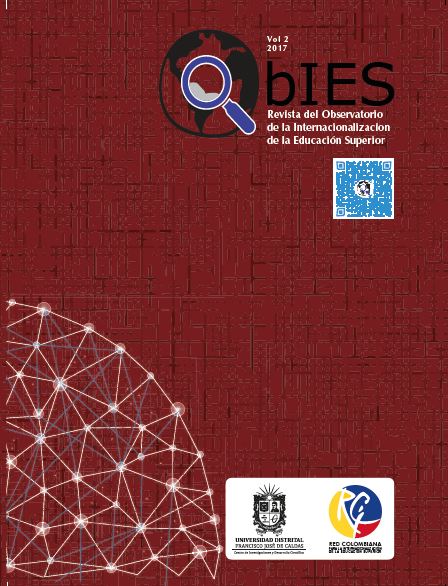DOI:
https://doi.org/10.14483/25905449.12738Publicado:
2017-11-19Número:
Vol. 2 (2018)Sección:
Artículos de ReflexiónReflections on the future of research, development and innovation in Colombia
Descargas
Resumen (es)
Colombia is going through a moment of historical change. After four years of formal peace negotiations and the signing of a peace agreement with the FARC in November 2016, the country is set to enter an era of increased stability. In this perspective, the Colombian government should concentrate its effort to respond to societal challenges by improving infrastructure, promoting social inclusion and a sustainable use of natural resources. However, while it is acknowledged that greater investments in science and technology could foster economic growth and development and respond to societal needs, Colombia is still lagging behind. Greater investment in science and technology with a long-term perspective should support the country’s efforts for growth and development. Furthermore, considering Colombia´s great diversity in terms of population, topography and societal needs, it appears reductive to apply a ‘one size fits all’ solution. This article presents some reflections on how strengthening the capacity of higher education institutions (HEIs) for research and internationalization and strengthening the link between knowledge, practice and policy would contribute to more and better research, development and innovation in Colombia.Referencias
OECD, (2017) Colombia: Elevar la productividad y lograr un crecimiento más inclusivo
Pardo Martínez, C, I. (2017), Los efectos de invertir en ciencia y tecnología, Observatorio de Ciencia y Tecnología – OcyT.
CONPES, (2016) Política nacional de ciencia, tecnología e innovación 2016-2025, (draft). The final document was never published and raising the critiques of the scientific community http://www.eltiempo.com/opinion/columnistas/moises-wasserman/el-documento-conpes-que-nunca-fue-68516
UNESCO, (2015), UNESCO Science Report, Towards 2030
Pardo Martínez, C, I. (2017), Los efectos de invertir en ciencia y tecnología, Observatorio de Ciencia y Tecnología - OcyT, ,
SELA, (2016), Panorama de la cooperación regionale internacional en ciencia, tecnología e innovación en América Latina.
Informe anual Indicadores de Ciencia y Tecnología Colombia 2015, Observatorio de Ciencia y Tecnología de Colombia,
El Espectador, (7th June 2016) Las 10 universidades colombianas con más grupos de investigación.
El Tiempo, (31st, March 2017) Abren convocatoria para Colombia Científica.
SELA, (2016), Panorama de la cooperación regional e internacional en ciencia, tecnología e innovación en América Latina
The EU has formal Science and Technology Cooperation Agreements with four countries of the region: Argentina, Brazil, Chile and Mexico. http://ec.europa.eu/research/iscp/index.cfm?pg=latin-americ-carib
Horizon 2020 is the biggest EU Research and Innovation program ever with nearly €80 billion of funding available over 7 years (2014 to 2020). https://ec.europa.eu/programmes/horizon2020/en/what-horizon-2020
Ministerio de Educación Nacional, (2015), Guías para la internacionalización de la educación superior, Internacionalización de la investigación
UNESCO,(2017). Regional overview: Latin America and the Caribbean- UNESCO Science Report, towards 2030
CIENCIASSEMFROTEIRAS, (2017), http://www.cienciasemfronteiras.gov.br
VALOR, (2017). MEC acaba com Ciência sem Fronteiras para graduação no exterior.
Colombia Científica, (2017) http://colombiacientifica.gov.co/colombia/
Colombia Científica, (2017). http://colombiacientifica.gov.co/colombia/quienes-somos/
Colciencias, (2017) “Programa Colombia Científica aportará al desarrollo de la capacidad investigativa del país”
As in the case of the Ciência sem Fronteiras program in Brazil, (2017)
Schwab K., (2017). The Global Competitiveness Report 2016–2017, World Economic Forum
Inter-American Development Bank, (2017). Urban Development by the Numbers
More than a third of the population lives below the poverty line, (2017)
Yuk, P.K., (2017). Colombia’s economy grows more than expected in Q2 Financial Time August 15, 2017
The Global Competitiveness Report 2016–2017, (2016).The Global Innovation Index 2017
The World Factbook-Colombia, (2017). People and Society/Demographic profile- USA, Central Intelligence Agency
OECD (2008). Ageing OECD Societies, ISBN 978-92-64-04661-0 Trends Shaping Education
United Nations (2015).Transforming our world: the 2030 Agenda for Sustainable Development,
The World Factbook-Colombia, (2017)/Energy- USA, Central Intelligence Agency
International Renewable Energy Agency (IRENA), (2015). OFF-GRID RENEWABLE ENERGY SYSTEMS: STATUS AND METHODOLOGICAL ISSUES (2015) -
Salazar J.F., (2014) “Desarrollo Tecnológico En Colombia”. Catedra! Published online 05 April 2014
With the phrase the “Golden Triangle, (2017). The Dutch Ministry of Economic Affairs, Agriculture and Innovation is referring to the successful collaboration of (agricultural) research/education, industry and government
OECD, (2017). Food and Agricultural Reviews, “Innovation, Agricultural Productivity and Sustainability in the
Netherlands”, p. 136, ISBN: 9789264238459.
Guarino A. and De Martinis D. (2016) “What Ails Italy: The Competitive Issue of the Italian State” American Journal of Economics, Finance and Management, Vol.2, No.5, Oct. 2016
Colglazier E. W. and Lyons, E. E. (2014) “The United States looks to the global science, technology and innovation horizon”. Science & Diplomacy, September 2014.
Miranda, J.B. (2016) “How can Colombia become more competitive?”. 17 Jun 2016, World Economic Forum
Achenbach, J. and L.H. Sun (2017) “Trump budget seeks huge cuts to science and medical research, disease prevention” The Washington Post. 23 May 2017
Gillespie P. (2015) “How Colombia went from murder capital to tech powerhouse”. CNN Money, March 13, 2015
Totten, M.J. (2016) Venezuela Collapses, Colombia Rises. World Affairs,
Wade, L. (2017) “Researchers thought peace in Colombia would mean more science funding. They were wrong”. Science, published online Sep. 6, 2017.




